Review of Key Technologies for Offshore Floating Wind Power Generation
Abstract
1. Introduction
2. Floating Offshore Wind Power Generation Technology
2.1. Types of Floating Wind Turbines

2.2. Attitude Stability Control Technology for Floating Offshore Wind Turbines
2.3. Response Characteristics Analysis of Floating Wind Turbine under Wind and Wave Loads
3. Floating Offshore Wind Storage Integration Technology
3.1. Offshore Energy Storage Technology
3.1.1. Pumped Storage
3.1.2. Compressed Air Energy Storage
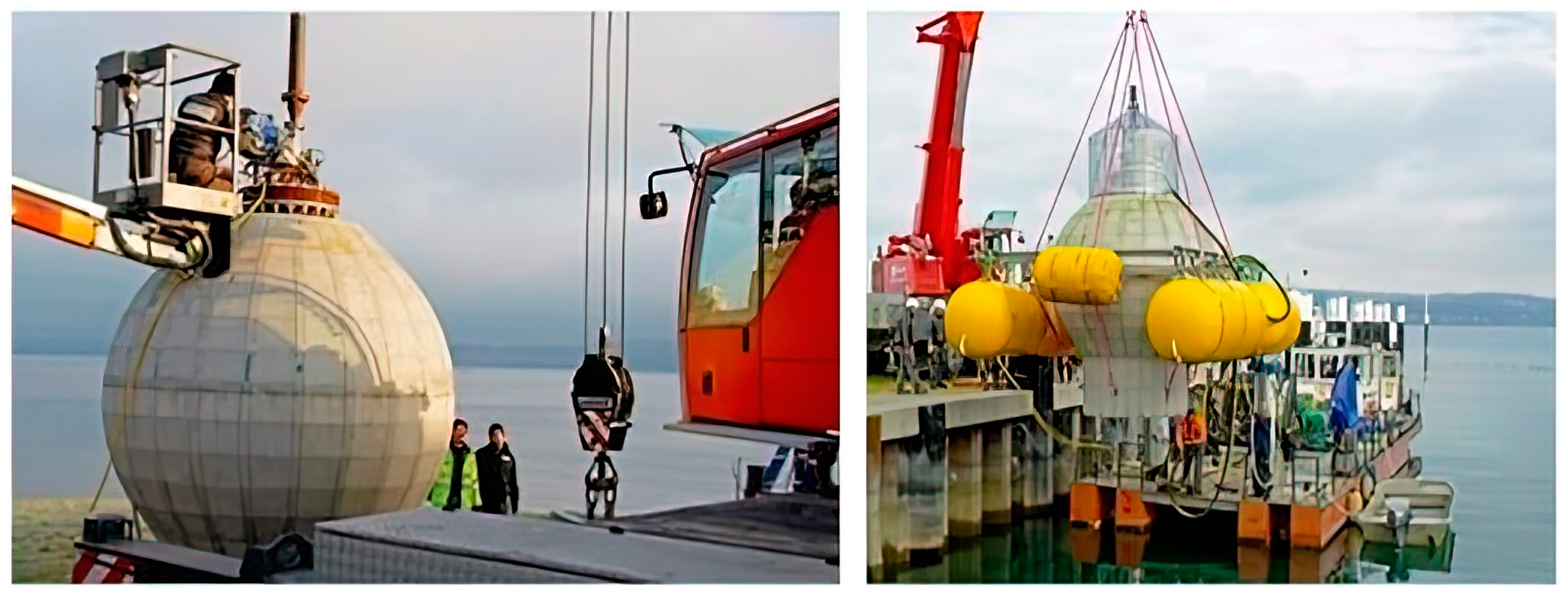

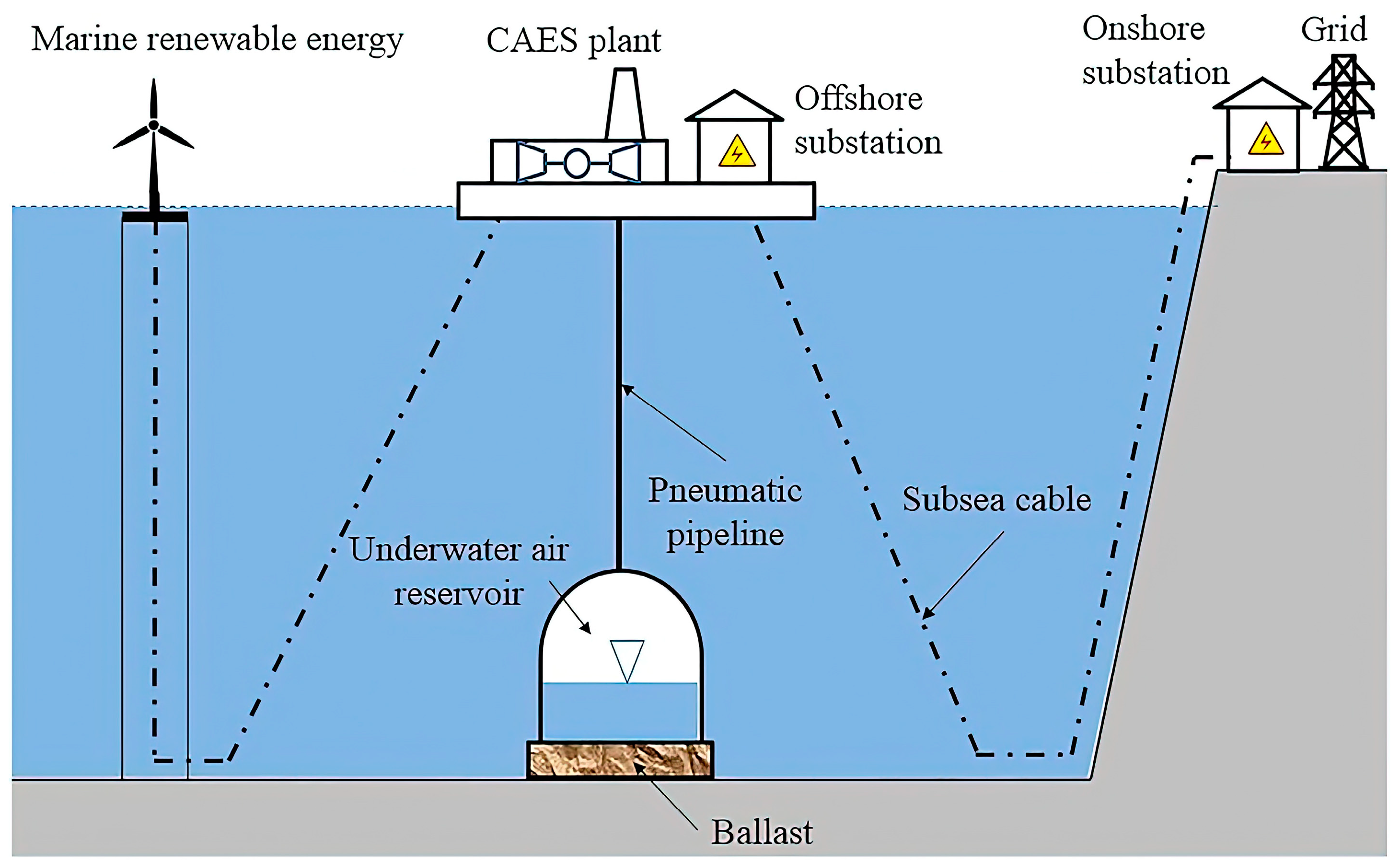
3.1.3. Electrochemical Energy Storage
- (1)
- Adaptation to the ambient temperature at sea;
- (2)
- Adaptation to vibration and shock;
- (3)
- Adaptation to humidity, salt spray, and moldy working environments;
- (4)
- No environmental hazards from battery leaks.
3.2. Control and Optimal Scheduling of Integrated Offshore Wind Storage System
4. Energy Management Technologies for Offshore Wind Power
4.1. Offshore Wind Power Prediction Techniques
4.2. Offshore Wind Farm Power Allocation

5. Long-Distance Transmission Technology for Floating Offshore Wind Farms
5.1. Offshore Wind Power Prediction Techniques
5.2. Control of Offshore Wind Power Long-Range Transmission Converter
6. Future Research Outlook
7. Conclusions
Author Contributions
Funding
Data Availability Statement
Acknowledgments
Conflicts of Interest
References
- Leung, D.Y.C.; Yang, Y. Wind energy development and its environmental impact: A review. Renew. Sustain. Energy Rev. 2012, 16, 1031–1039. [Google Scholar] [CrossRef]
- Zheng, C.; Song, H.; Liang, F.; Jin, Y.P.; Wang, D.Y.; Tian, Y.C. Climatic Temporal-Spatial Distribution of Offshore Wind Energy in the Maritime Silk Road, 1st ed.; Springer: Singapore, 2021; pp. 29–63. [Google Scholar]
- Global Wind Energy Council. Global Offshore Wind Wind Report 2021: Technical Report; GWEC: Brussels, Belgium, 2021. [Google Scholar]
- Gao, W.; Li, C.; Ye, Z. The current situation and latest research of deep-sea floating wind turbine. Strateg. Study CAE 2014, 16, 79–87. [Google Scholar]
- Aljafari, B.; Samithas, D.; Balachandran, P.K.; Anandan, S.; Babu, T.S. Performance Analysis of PLA Material Based Micro-Turbines for Low Wind Speed Applications. Polymers 2022, 14, 4180. [Google Scholar] [CrossRef]
- Wan, D.C.; Cheng, P.; Huang, Y.; Ai, Y. Overview of study on aero-and hydrodynamic interaction for floating offshore wind turbines. Chin. Q. Mech. 2017, 38, 385. [Google Scholar]
- Cheng, P.; Huang, Y.; Wan, D. A numerical model for fully coupled aero-hydrodynamic analysis of floating offshore wind turbine. Ocean Eng. 2019, 173, 183–196. [Google Scholar] [CrossRef]
- Hallowell, S.T.; Arwade, S.R.; Fontana, C.M.; DeGroot, D.J.; Aubeny, C.P.; Diaz, B.D.; Myers, A.T.; Landon, M.E. System reliability of floating offshore wind farms with multiline anchors. Ocean Eng. 2018, 160, 94–104. [Google Scholar] [CrossRef]
- Bashetty, S.; Ozcelik, S. Review on Dynamics of Offshore Floating Wind Turbine Platforms. Energies 2021, 14, 6026. [Google Scholar] [CrossRef]
- López-Queija, J.; Robles, E.; Jugo, J.; Alonso-Quesada, S. Review of control technologies for floating offshore wind turbines. Renew. Sustain. Energy Rev. 2022, 167, 112787. [Google Scholar] [CrossRef]
- Basbas, H.; Liu, Y.C.; Laghrouche, S.; Hilairet, M.; Plestan, F. Review on Floating Offshore Wind Turbine Models for Nonlinear Control Design. Energies 2022, 15, 5477. [Google Scholar] [CrossRef]
- Lamei, A.; Hayatdavoodi, M. On motion analysis and elastic response of floating offshore wind turbines. J. Ocean Eng. Mar. Energy 2020, 6, 71–90. [Google Scholar] [CrossRef]
- Ramachandran, C.R.; Desmond, C.; Judge, F.; Serraris, J.J.; Murphy, J. Floating offshore wind turbines: Installation, operation, maintenance and decommissioning challenges and opportunities. Wind. Energy Sci. Discuss. 2021, 2021, 15. [Google Scholar]
- Li, Z.; Song, Q.; An, F.; Zhao, B.; Yu, Z.; Zeng, R. Review on DC transmission systems for integrating large-scale offshore wind farms. Energy Convers. Econ. 2021, 2, 1–14. [Google Scholar] [CrossRef]
- Zhang, Y.; Ravishankar, J.; Fletcher, J.; Li, R.; Han, M. Review of modular multilevel converter based multi-terminal HVDC systems for offshore wind power transmission. Renew. Sustain. Energy Rev. 2016, 61, 572–586. [Google Scholar] [CrossRef]
- Wang, C.M.; Utsunomiya, T.; Wee, S.C.; Choo, Y.S. Research on floating wind turbines: A literature survey. IES J. Part A Civ. Struct. Eng. 2010, 3, 267–277. [Google Scholar] [CrossRef]
- Xu, X.; Day, S. Experimental investigation on dynamic responses of a spar-type offshore floating wind turbine and its mooring system behaviour. Ocean Eng. 2021, 236, 109488. [Google Scholar] [CrossRef]
- Shi, W.; Jiang, J.; Sun, K.; Ju, Q. Aerodynamic performance of semi-submersible floating wind turbine under pitch motion. Sustain. Energy Technol. Assess. 2021, 48, 101556. [Google Scholar] [CrossRef]
- Oguz, E.; Clelland, D.; Day, A.H.; Incecik, A.; López, J.A.; Sánchez, G.; Almeria, G.G. Experimental and numerical analysis of a TLP floating offshore wind turbine. Ocean Eng. 2018, 147, 591–605. [Google Scholar] [CrossRef]
- Jonkman, J.M.; Matha, D. Dynamics of offshore floating wind turbines—Analysis of three concepts. Wind Energy 2011, 14, 557–569. [Google Scholar] [CrossRef]
- Jonkman, J.M.; Buhl, M.L. Loads analysis of a floating offshore wind turbine using fully coupled simulation. In Proceedings of the Wind Power 2007 Conference and Exhibition, Los Angeles, CA, USA, 3–6 June 2007. [Google Scholar]
- Villoslada, D.; Santos, M.; Tomás-Rodríguez, M. TMD stroke limiting influence on barge-type floating wind turbines. Ocean Eng. 2022, 248, 110781. [Google Scholar] [CrossRef]
- Sierra-García, J.E.; Santos, M. Neural networks and reinforcement learning in wind turbine control. Rev. Iberoam. De Automática E Inf. Ind. 2021, 18, 327–335. [Google Scholar] [CrossRef]
- Galán-Lavado, A.; Santos, M. Analysis of the effects of the location of passive control devices on the platform of a floating wind turbine. Energies 2021, 14, 2850. [Google Scholar] [CrossRef]
- Jin, Q.; Li, X.; Sun, N.; Zhou, J.; Guan, J. Experimental and numerical study on tuned liquid dampers for controlling earthquake response of jacket offshore platform. Mar. Struct. 2007, 20, 238–254. [Google Scholar] [CrossRef]
- Coudurier, C.; Lepreux, O.; Petit, N. Modelling of a tuned liquid multi-column damper. Application to floating wind turbine for improved robustness against wave incidence. Ocean Eng. 2018, 165, 277–292. [Google Scholar] [CrossRef]
- Jaksic, V.; Wright, C.S.; Murphy, J.; Afeef, C.; Ali, S.F.; Mandic, D.P.; Pakrashi, V. Dynamic response mitigation of floating wind turbine platforms using tuned liquid column dampers. Philos. Trans. R. Soc. A 2015, 373, 20140079. [Google Scholar] [CrossRef]
- Mousavi, S.A.; Bargi, K.; Zahrai, S.M. Optimum parameters of tuned liquid column–gas damper for mitigation of seismic-induced vibrations of offshore jacket platforms. Struct. Control. Health Monit. 2013, 20, 422–444. [Google Scholar] [CrossRef]
- Hokmabady, H.; Mojtahedi, A.; Mohammadyzadeh, S.; Ettefagh, M.M. Structural control of a fixed offshore structure using a new developed tuned liquid column ball gas damper (TLCBGD). Ocean Eng. 2019, 192, 106551. [Google Scholar] [CrossRef]
- He, X.Y.; Li, H.N. Suppression of random wave-induced vibrations in offshore platform by tuned liquid column damper. J. Vib. Eng. 2008, 1, 71–78. [Google Scholar]
- Hochrainer, M.J. Active tuned liquid column gas damper in structural control. Dyn. Civ. Struct. 2015, 2, 467–473. [Google Scholar]
- Yang, J.; He, E.M.; Hu, Y.Q. Dynamic modeling and vibration suppression for an offshore wind turbine with a tuned mass damper in floating platform. Appl. Ocean. Res. 2019, 83, 21–29. [Google Scholar] [CrossRef]
- Dinh, V.N.; Basu, B. Passive control of floating offshore wind turbine nacelle and spar vibrations by multiple tuned mass dampers. Struct. Contr. Health Monit. 2015, 22, 152–176. [Google Scholar] [CrossRef]
- Lu, Z.; Huang, B.; Zhang, Q.; Lu, X. Experimental and analytical study on vibration control effects of eddy-current tuned mass dampers under seismic excitations. J. Sound Vib. 2018, 421, 153–165. [Google Scholar] [CrossRef]
- Yang, D.; Gao, X.; Cui, E.; Ma, Z. State-constraints adaptive backstepping control for active magnetic bearings with parameters nonstationarities and uncertainties. IEEE Trans. Ind. Electron. 2020, 68, 9822–9831. [Google Scholar] [CrossRef]
- Lian, J.J.; Zhao, Y.; Lian, C.; Dong, X.F.; Wang, H.J. Vibration reduction of offshore wind turbine tube infrastructures based on EC-TMD. J. Vib. Shock. 2019, 38, 20–25. [Google Scholar]
- Yang, Y.; Leng, D.X.; Xu, K.; Liu, G.J.; Tian, X.J.; Xie, Y.C.; Wang, H.H. Application of magnetorheological TMD in vibration control of offshore wind turbine. J. Chongqing Univ. 2022, 45, 20–30. [Google Scholar]
- Jahangiri, V.; Sun, C. Three-dimensional vibration control of offshore floating wind turbines using multiple tuned mass dampers. Ocean Eng. 2020, 206, 107196. [Google Scholar] [CrossRef]
- Robertson, A.N.; Jonkman, J.M. Loads analysis of several offshore floating wind turbine concepts. In Proceedings of the Twenty-first International Offshore and Polar Engineering Conference, Maui, HI, USA, 19–24 June 2011. [Google Scholar]
- Li, L.; Liu, Y.; Yuan, Z.; Gao, Y. Wind field effect on the power generation and aerodynamic performance of offshore floating wind turbines. Energy 2018, 157, 379–390. [Google Scholar] [CrossRef]
- Jang, H.K.; Park, S.; Kim, M.H.; Kim, K.H.; Hong, K. Effects of heave plates on the global performance of a multi-unit floating offshore wind turbine. Renew. Energy 2019, 134, 526–537. [Google Scholar] [CrossRef]
- Chen, Z.; Wang, X.; Guo, Y.; Kang, S. Numerical analysis of unsteady aerodynamic performance of floating offshore wind turbine under platform surge and pitch motions. Renew. Energy 2021, 163, 1849–1870. [Google Scholar] [CrossRef]
- Wen, B.; Tian, X.; Dong, X.; Peng, Z.; Zhang, W. Influences of surge motion on the power and thrust characteristics of an offshore floating wind turbine. Energy 2017, 141, 2054–2068. [Google Scholar] [CrossRef]
- Wu, H.Y.; Deng, C.H.; Li, D.L.; Yao, W.W.; Zhang, H.; Ying, H.H. A multi-time scale optimal dispatching method for combined operation of offshore wind power and seawater pumped storage. Eng. J. Wuhan Univ. 2021, 54, 361–368. [Google Scholar]
- Yao, W.; Deng, C.; Li, D.; Chen, M.; Peng, P.; Zhang, H. Optimal sizing of seawater pumped storage plant with variable-speed units considering offshore wind power accommodation. Sustainability 2019, 11, 1939. [Google Scholar] [CrossRef]
- Ioakimidis, C.S.; Genikomsakis, K.N. Integration of seawater pumped-storage in the energy system of the Island of São Miguel (Azores). Sustainability 2018, 10, 3438. [Google Scholar] [CrossRef]
- Puchta, M.; Bard, J.; Dick, C.; Hau, D.; Krautkremer, B.; Thalemann, F.; Hahn, H. Development and testing of a novel offshore pumped storage concept for storing energy at sea-Stensea. J. Energy Storage 2017, 14, 271–275. [Google Scholar] [CrossRef]
- Hahn, H.; Hau, D.; Dick, C.; Puchta, M. Techno-economic assessment of a subsea energy storage technology for power balancing services. Energy 2017, 133, 121–127. [Google Scholar] [CrossRef]
- Wang, Z.W.; Xiong, W.; Wang, H.T.; Wang, Z.W. A review on underwater compressed air energy storage. Energy Storage Sci. Technol. 2015, 4, 585–598. [Google Scholar]
- He, W.; Wang, J. Optimal selection of air expansion machine in Compressed Air Energy Storage, A review. Renew. Sustain. Energy Rev. 2018, 87, 77–95. [Google Scholar] [CrossRef]
- Wang, Z.; Ting, D.S.K.; Carriveau, R.; Xiong, W.; Wang, Z. Design and thermodynamic analysis of a multilevel underwater compressed air energy storage system. J. Energy Storage 2016, 5, 203–211. [Google Scholar] [CrossRef]
- Guo, H.; Xu, Y.; Zhu, Y.; Zhang, X.; Yin, Z.; Chen, H. Coupling properties of thermodynamics and economics of underwater compressed air energy storage systems with flexible heat exchanger model. J. Energy Storage 2021, 43, 103198. [Google Scholar] [CrossRef]
- Wang, Z.; Carriveau, R.; Ting, D.S.K.; Xiong, W.; Wang, Z. A review of marine renewable energy storage. Int. J. Energy Res. 2019, 43, 6108–6150. [Google Scholar] [CrossRef]
- Luo, X.; Wang, J.; Dooner, M.; Clarke, J. Overview of current development in electrical energy storage technologies and the application potential in power system operation. Appl. Energy 2015, 137, 511–536. [Google Scholar] [CrossRef]
- Bussar, R.; Lippert, M.; Bonduelle, G.; Linke, R.; Crugnola, G.; Cilia, J.; Merz, K.D.; Heron, C.; Marckx, E. Battery Energy Storage for Smart Grid Applications. EuroBat. 2013. Available online: https://www.eurobat.org/wp-content/uploads/2021/09/eurobat_smartgrid_publication_may_2013.pdf (accessed on 1 November 2022).
- Lisbona, D.; Snee, T. A review of hazards associated with primary lithium and lithium-ion batteries. Process Saf. Environ. Prot. 2011, 89, 434–442. [Google Scholar] [CrossRef]
- Simpson, J.G.; Hanrahan, G.; Loth, E.; Koenig, G.M.; Sadoway, D.R. Liquid metal battery storage in an offshore wind turbine: Concept and economic analysis. Renew. Sustain. Energy Rev. 2021, 149, 111387. [Google Scholar] [CrossRef]
- Zhang, Z.Y.; Guo, X.L.; Zhang, X.S.; Ma, X.Y. Strategy of smoothing wind power fluctuation with storage battery based on moving average and model predictive control. Control. Eng. China 2019, 26, 114–119. [Google Scholar]
- Liu, X.L.; Liu, C.J.; Xu, Z.C. Wind/Storage coordination control strategy based on wavelet packet decomposition. Power Electron. 2019, 53, 77–79. [Google Scholar]
- Zhang, G.F.; Yang, J.Y.; Wang, H.X.; Xie, C.J. Coordinated frequency modulation control strategy of wind farm-storage system based on virtual synchronous generator technology. Trans. China Electrotech. Soc. 2022, 37, 83–92. [Google Scholar]
- Li, K.; Wang, S.; Tao, Y.; Wang, Q.; Yao, L.; Yu, H. Frequency Fuzzy Control Strategy for Coordinated Wind-Storage System Considering Energy Storage Capacity Optimization. In Proceedings of the 2022 5th International Conference on Energy, Electrical and Power Engineering (CEEPE), Chongqing, China, 22–24 April 2022; pp. 1036–1041. [Google Scholar]
- Su, D.; Hao, Y.; Li, W.; Dai, R.; Zhou, X. Cluster Division and Optimal Scheduling of Offshore Wind Power with Energy Storage Based on Fast Unfolding Algorithm. In Proceedings of the 2022 IEEE 5th International Electrical and Energy Conference (CIEEC), Nanjing, China, 27–29 May 2022; pp. 5082–5086. [Google Scholar]
- Ji, X.P.; Liu, Z.; Liu, W.; Zhang, X. Collaborative Control of Integrated Generation and Storage for Offshore Wind Turbines. In Proceedings of the 2019 IEEE Innovative Smart Grid Technologies-Asia (ISGT Asia), Chengdu, China, 21–24 May 2019; pp. 1644–1649. [Google Scholar]
- Falcão, J.; Castro, R. Ferreira de Jesus J M. Frequency control during transients in offshore wind parks using battery energy storage systems. J. Mar. Eng. Technol. 2016, 15, 57–68. [Google Scholar] [CrossRef]
- Liu, Y.; Wang, G.; Gao, Z.; Han, Z.A. Frequency control strategy for offshore wind power based on electrochemical energy storage. In Proceedings of the 2022 7th Asia Conference on Power and Electrical Engineering (ACPEE), Online, 15–17 April 2022; pp. 301–305. [Google Scholar]
- Paul, S.; Nath, A.P.; Rather, Z.H. A multi-objective planning framework for coordinated generation from offshore wind farm and battery energy storage system. IEEE Trans. Sustain. Energy 2019, 11, 2087–2097. [Google Scholar] [CrossRef]
- Tian, W.; Tan, Y.; Li, Y.; Cao, Y.; Qiao, X.; Li, Q.; Chen, S.; Hu, B. Optimal Multiperiod Dispatch for Hybrid VSC-MTDC and AC Grids by Coordination of Offshore Wind Farm and Battery Energy Storage. In Proceedings of the IECON 2017-43rd Annual Conference of the IEEE Industrial Electronics Society, Beijing, China, 29–31 October 2017; pp. 5935–5939. [Google Scholar]
- Wang, X.; Li, L.; Palazoglu, A.; El-Farra, N.H.; Shah, N. Optimization and control of offshore wind systems with energy storage. Energy Convers. Manag. 2018, 173, 426–437. [Google Scholar] [CrossRef]
- Liu, X.; Li, N.; Mu, H.; Li, M.; Liu, X. Techno-energy-economic assessment of a high capacity offshore wind-pumped-storage hybrid power system for regional power system. J. Energy Storage 2021, 41, 102892. [Google Scholar] [CrossRef]
- Hanifi, S.; Liu, X.; Lin, Z.; Lotfian, S. A critical review of wind power forecasting methods—Past, present and future. Energies 2020, 13, 3764. [Google Scholar] [CrossRef]
- Zhang, J.; Yan, J.; Infield, D.; Liu, Y.; Lien, F.S. Short-term forecasting and uncertainty analysis of wind turbine power based on long short-term memory network and Gaussian mixture model. Appl. Energy 2019, 241, 229–244. [Google Scholar] [CrossRef]
- Han, Z.; Jing, Q.; Zhang, Y.; Bai, R.Q.; Guo, K.M.; Zhang, Y. Review of wind power forecasting methods and new trends. Power Syst. Prot. Control. 2019, 47, 178–187. [Google Scholar]
- Soman, S.S.; Zareipour, H.; Malik, O.; Mandal, P. A Review of Wind Power and Wind Speed Forecasting Methods with Different Time Horizons. In Proceedings of the North American power symposium, Arlington, TX, USA, 26–28 September 2010; pp. 1–8. [Google Scholar]
- Yang, D.; Gao, X.; Kong, L.; Pang, Y.; Zhou, B. An event-driven convolutional neural architecture for non-intrusive load monitoring of residential appliance. IEEE Trans. Consum. Electron. 2020, 66, 173–182. [Google Scholar] [CrossRef]
- Foley, A.M.; Leahy, P.G.; Marvuglia, A.; McKeogh, E.J. Current methods and advances in forecasting of wind power generation. Renew. Energy 2012, 37, 1–8. [Google Scholar] [CrossRef]
- Wang, Y.; Zhu, B.; Zhang, H.; Zheng, W.X. Functional observer-based finite-time adaptive ISMC for continuous systems with unknown nonlinear function. Automatica 2021, 125, 109468. [Google Scholar] [CrossRef]
- Chang, W.Y. A literature review of wind forecasting methods. J. Power Energy Eng. 2014, 2, 161. [Google Scholar] [CrossRef]
- Wang, Y.; Qiu, X.; Zhang, H.; Xie, X. Data-driven-based event-triggered control for nonlinear CPSs against jamming attacks. IEEE Trans. Neural Netw. Learn. Syst. 2021, 33, 3171–3177. [Google Scholar] [CrossRef]
- Su, X.J.; Zhou, W.X.; Li, C.J.; Mi, Y.; Fu, Y.; Dong, Z.Y. Interpretable offshore wind power output forecasting based on long short-term memory neural network with dual-stage attention. Autom. Electr. Power Syst. 2022, 46, 141–151. [Google Scholar]
- Fu, Y.; Ren, Z.X.; Wei, S.R.; Wang, Y.; Huang, L.L.; Jia, F. Ultra-short-term power prediction of offshore wind power based on improved LSTM-TCN model. Proc. CSEE 2022, 42, 4292–4303. [Google Scholar]
- Qi, C.C.; Wang, X.W. Short-term prediction of offshore wind power considering wind direction and atmospheric stability. Power Syst. Technol. 2021, 45, 2773–2780. [Google Scholar]
- Lu, H.; Ma, X.; Huang, K.; Azimi, M. Prediction of offshore wind farm power using a novel two-stage model combining kernel-based nonlinear extension of the Arps decline model with a multi-objective grey wolf optimizer. Renew. Sustain. Energy Rev. 2020, 127, 109856. [Google Scholar] [CrossRef]
- Lin, Z.; Liu, X.; Collu, M. Wind power prediction based on high-frequency SCADA data along with isolation forest and deep learning neural networks. Int. J. Electr. Power Energy Syst. 2020, 118, 105835. [Google Scholar] [CrossRef]
- Zheng, X.; Qi, X.; Liu, H.; Liu, X.; Li, Y. Deep Neural Network for Short-Term Offshore Wind Power Forecasting. In Proceedings of the 2018 OCEANS-MTS/IEEE Kobe Techno-Oceans (OTO), Kobe, Japan, 28–31 May 2018; pp. 1–5. [Google Scholar]
- Dokur, E.; Erdogan, N.; Salari, M.E.; Karakuzu, C.; Murphy, J. Offshore wind speed short-term forecasting based on a hybrid method: Swarm decomposition and meta-extreme learning machine. Energy 2022, 248, 123595. [Google Scholar] [CrossRef]
- Amaral, L.; Castro, R. Offshore wind farm layout optimization regarding wake effects and electrical losses. Eng. Appl. Artif. Intell. 2017, 60, 26–34. [Google Scholar] [CrossRef]
- Yang, K.; Kwak, G.; Cho, K.; Huh, J. Wind farm layout optimization for wake effect uniformity. Energy 2019, 183, 983–995. [Google Scholar] [CrossRef]
- Wang, J.; Duan, B.; Su, Y.X. Optimization of Active Power Output in Offshore Wind Farms Based on Wake Effect. Autom. Electr. Power Syst. 2015, 39, 26–32. [Google Scholar]
- Wu, Y.L.; Guo, X.X.; Su, Y.X.; Qiao, H.X.; Duan, B.; Tan, M. Effective Optimization Method for Offshore Wind Farm Considering comprenensiIve Coordination of Yaw and Active Power Among Wind Turbines. Autom. Electr. Power Syst. 2017, 41, 74–80. [Google Scholar]
- Jin, W.J. Numerical Simulation of Wind Turbine Wakes based on Actuator Line Method in NEK5000. Master’s Thesis, Royal Institute of Technology, Stockholm, Sweden, 2013. [Google Scholar]
- Li, X.; Zhang, W. Long-term fatigue damage assessment for a floating offshore wind turbine under realistic environmental conditions. Renew. Energy 2020, 159, 570–584. [Google Scholar] [CrossRef]
- Su, Y.X.; Duan, B.; Zhu, G.H.; Fan, Y.H. Fatigue distribution and active power combined control in offshore wind farm. Trans. China Electrotech. Soc. 2015, 30, 190–198. [Google Scholar]
- Liao, H.; Hu, W.; Wu, X.; Wang, N.; Liu, Z.; Huang, Q.; Chen, C.; Chen, Z. Active power dispatch optimization for offshore wind farms considering fatigue distribution. Renew. Energy 2020, 151, 1173–1185. [Google Scholar] [CrossRef]
- Wang, B.; Tang, Z.; Gao, X.; Liu, W.; Chen, X. Distributed Control Strategy of the Leader-Follower for Offshore Wind Farms under Fault Conditions. Sustainability 2019, 11, 2290. [Google Scholar] [CrossRef]
- Nguyen, T.T.; Kim, H.M. Leader-Following Diffusion-Based Reactive Power Coordination and Voltage Control of Offshore Wind Farm. IEEE Access 2020, 8, 149555–149568. [Google Scholar] [CrossRef]
- Meng, Y.; Yan, S.; Wu, K.; Ning, L.; Li, X.; Wang, X.; Wang, X. Comparative economic analysis of low frequency AC transmission system for the integration of large offshore wind farms. Renew. Energy 2021, 179, 1955–1968. [Google Scholar] [CrossRef]
- Shu, Q.; Chen, G. Research on Circulating Current Suppression Strategy of Modular Multilevel Converter. In Proceedings of the Sixth International Conference on Electromechanical Control Technology and Transportation (ICECTT 2021), Chongqing, China, 14–16 May 2021; pp. 29–35. [Google Scholar]
- Xu, J.; Feng, M.; Liu, H.; Li, S.; Xiong, X.; Zhao, C. The diode-clamped half-bridge MMC structure with internal spontaneous capacitor voltage parallel-balancing behaviors. Int. J. Electr. Power Energy Syst. 2018, 100, 139–151. [Google Scholar] [CrossRef]
- Zhang, Z.R.; Tang, Y.J.; Fu, C.X. HVDC Transmission scheme of grid-following medium-frequency distant offshore wind farm for offshore platform miniaturization. Autom. Electr. Power Syst. 2021, 45, 139–148. [Google Scholar]
- Domínguez-García, J.L.; Rogers, D.J.; Ugalde-Loo, C.E.; Liang, J.; Gomis-Bellmunt, O. Effect of non-standard operating frequencies on the economic cost of offshore AC networks. Renew. Energy 2012, 44, 267–280. [Google Scholar] [CrossRef]
- Li, Z.; Song, Q.; Zeng, R.; Yu, Z.; Zhao, B. A novel HVDC system integrating offshore wind farms using series-connected distributed MMCs and medium-frequency AC collection network. Proc. CSEE 2021, 41, 7608–7621. [Google Scholar]
- Fang, Z.X.; Cai, X.; Shi, X.Q.; Cha, K.P.; Cao, J.Z.; Rao, F.Q. Topology optimization and control of the hybrid DC converter for offshore wind farms. Proc. CSEE 2021, 41, 8546–8560. [Google Scholar]
- Yao, H.Y.; Xie, Y.Y.; Fang, T.X.; Jiang, T.G.; Duan, J. Concentrated DC energy braking device with discharge controllable sub-module topology and lts control. High Voltage Eng. 2021, 47, 2896–2904. [Google Scholar]
- Wu, S.; Zhang, X.; Jia, W.; Zhu, Y.; Qi, L.; Guo, X.; Pan, X. A Modular Multilevel Converter with Integrated Energy Dissipation Equipment for Offshore Wind VSC-HVDC System. IEEE Trans. Sustain. Energy 2021, 13, 353–362. [Google Scholar] [CrossRef]
- Wang, X.; Zhao, B.; Huang, M.; YE, R. Research of Integration Methods Comparison and Key Design Technologies for Large Scale Long Distance Offshore Wind Power. J. Glob. Energy Interconnect 2019, 2, 138–145. [Google Scholar]
- Cai, L.; Karaagac, U.; Mahseredjian, J. Simulation of start-up sequence of an offshore wind farm with MMC-HVDC grid connection. IEEE Trans. Power Deliv. 2016, 32, 638–646. [Google Scholar] [CrossRef]
- Wang, P.; Zhang, X.P.; Coventry, P.F.; Zhang, R. Start-up control of an offshore integrated MMC multi-terminal HVDC system with reduced DC voltage. IEEE Trans. Power Syst. 2015, 31, 2740–2751. [Google Scholar] [CrossRef]
- Yan, F.; Wang, P.; Zhang, X.P.; Xie, J.; Li, X.; Tang, C.; Zhao, Z. Coordinated start-up control and inter-converter oscillations damping for MMC-HVDC grid. IEEE Access 2019, 7, 65093–65102. [Google Scholar] [CrossRef]
- Ye, H.H.; Cao, W.; Chen, W.; Wu, H.; He, G.Q.; Li, G.H.; Xi, Y.N.; Liu, Q.S. An AC Fault Ride Through Method for MMC-HVDC System in Offshore Applications Including DC Current-Limiting Inductors. IEEE Trans. Power Deliv. 2021, 37, 2818–2830. [Google Scholar] [CrossRef]
- Freytes, J.; Li, J.; de Préville, G.; Thouvenin, M. Grid-forming control with current limitation for MMC under unbalanced fault ride-through. IEEE Trans. Power Deliv. 2021, 36, 1914–1916. [Google Scholar] [CrossRef]
- Li, W.; Zhu, M.; Chao, P.; Liang, X.; Xu, D. Enhanced FRT and postfault recovery control for MMC-HVDC connected offshore wind farms. IEEE Trans. Power Syst. 2019, 35, 1606–1617. [Google Scholar] [CrossRef]
- Li, Y.H.; Kong, L. Developing solar and wind power generation technology to accelerate China’s energy transformation. Bull. Chin. Acad. Sci. 2019, 34, 426–433. [Google Scholar]
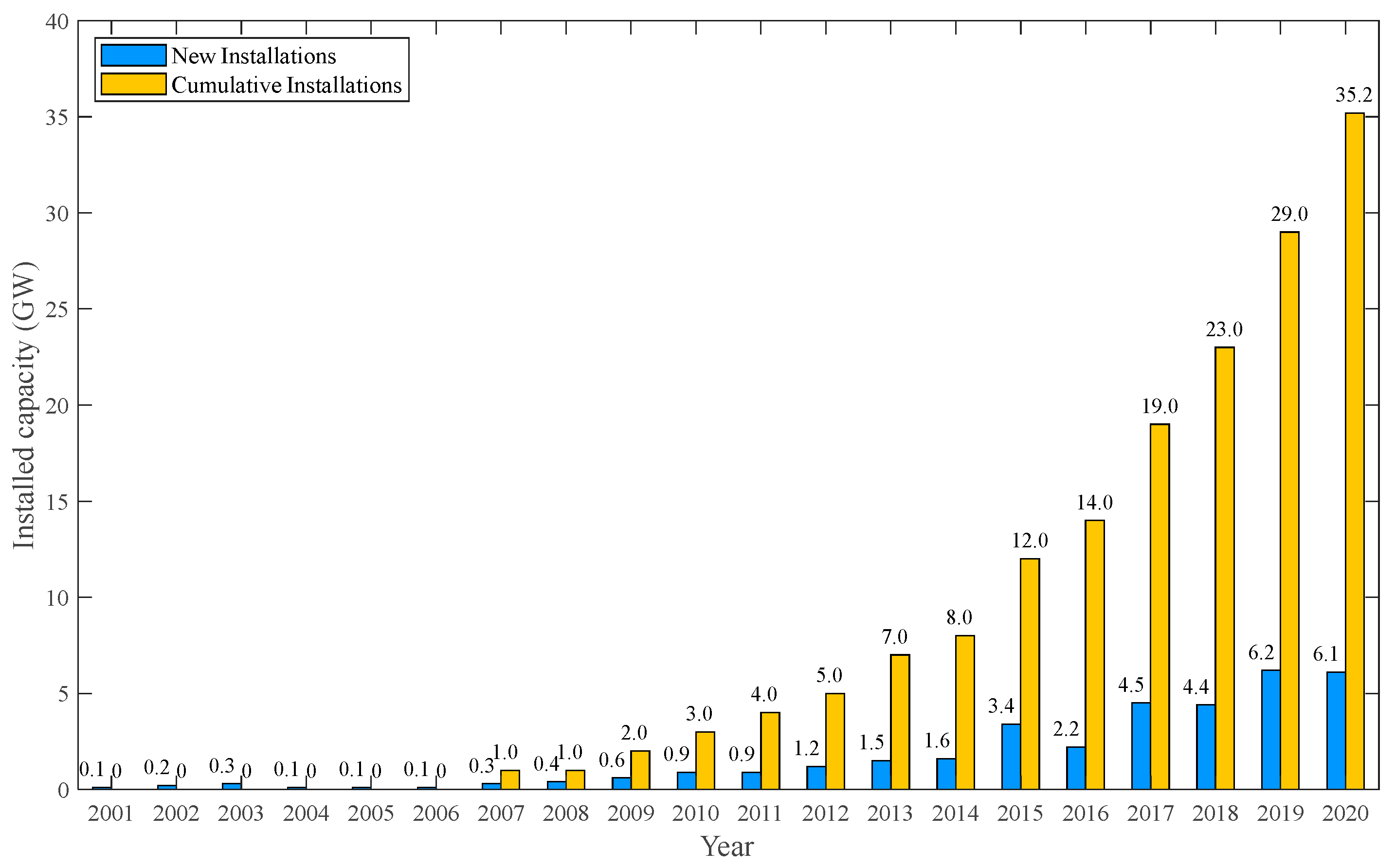
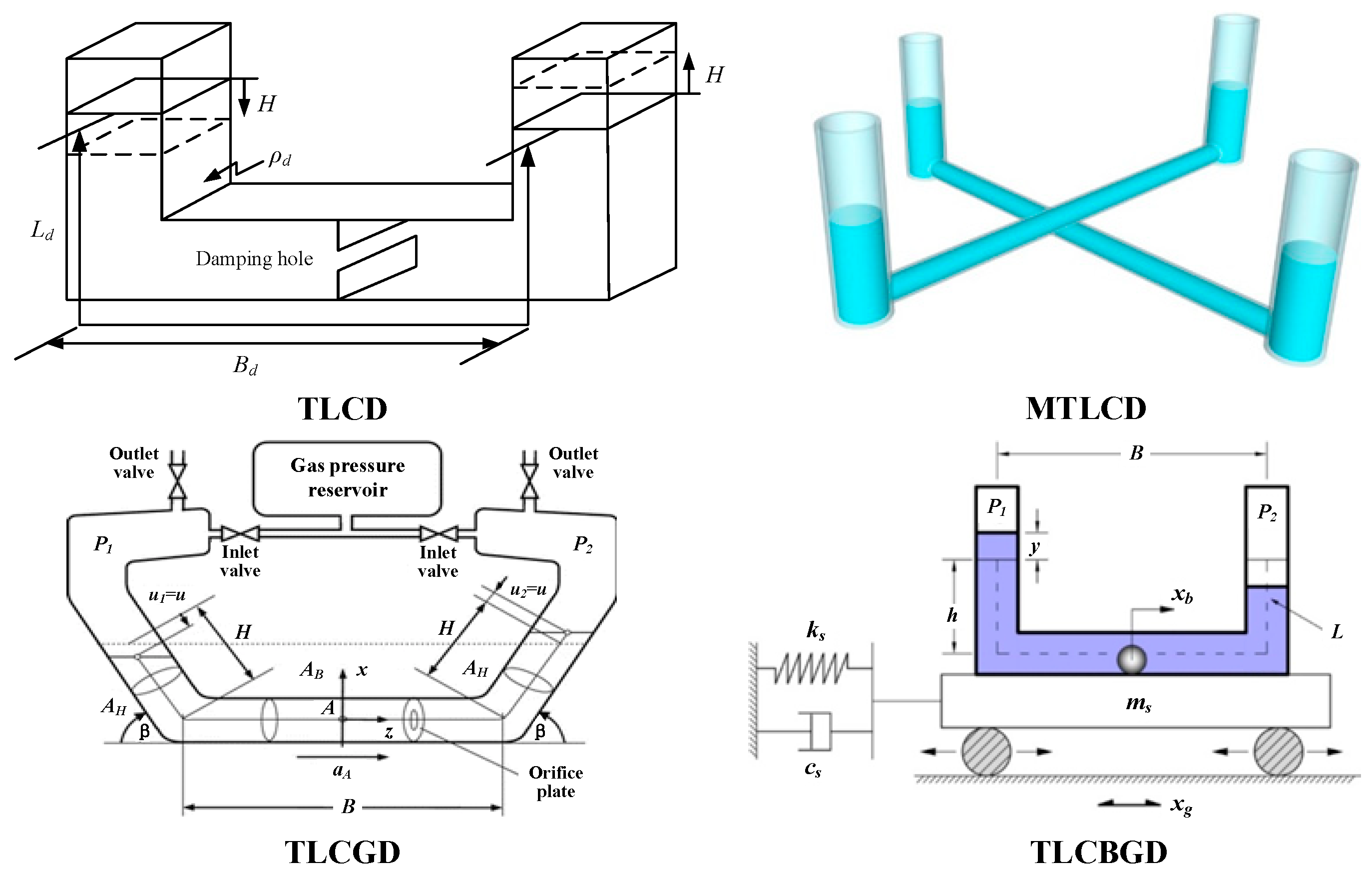
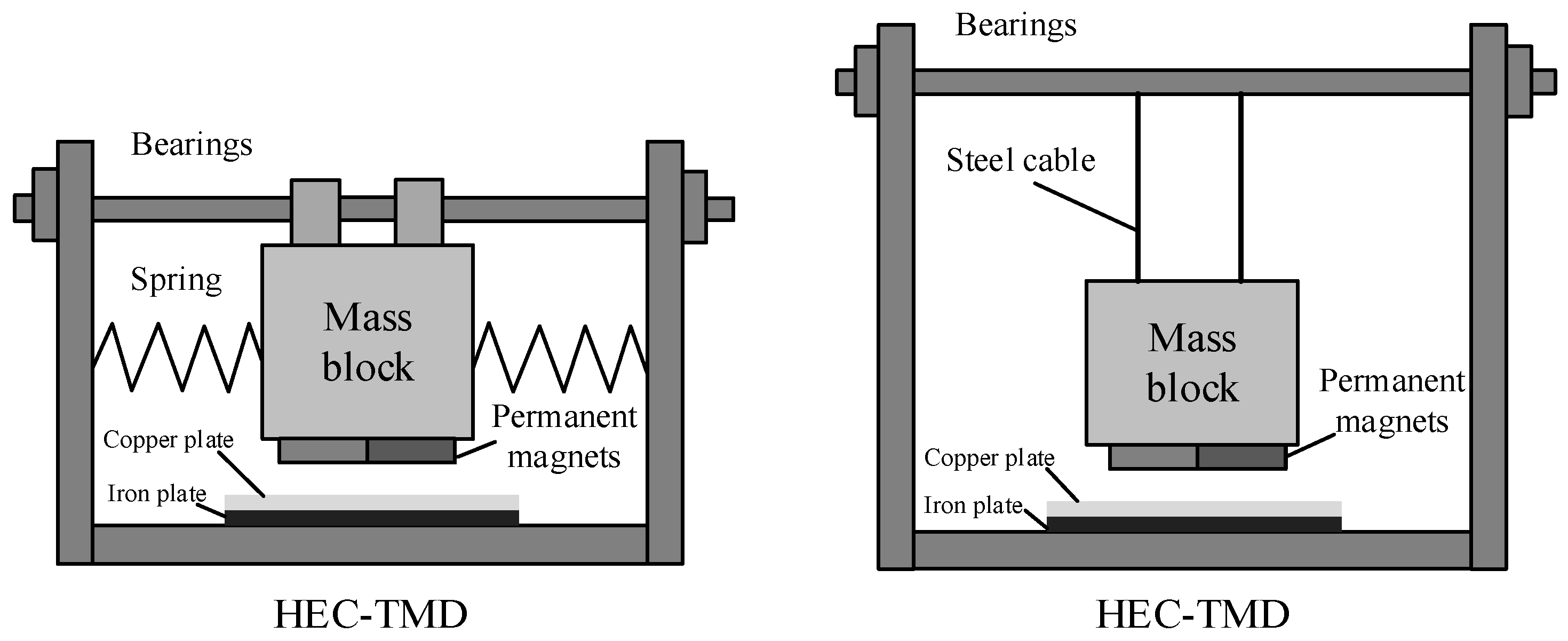
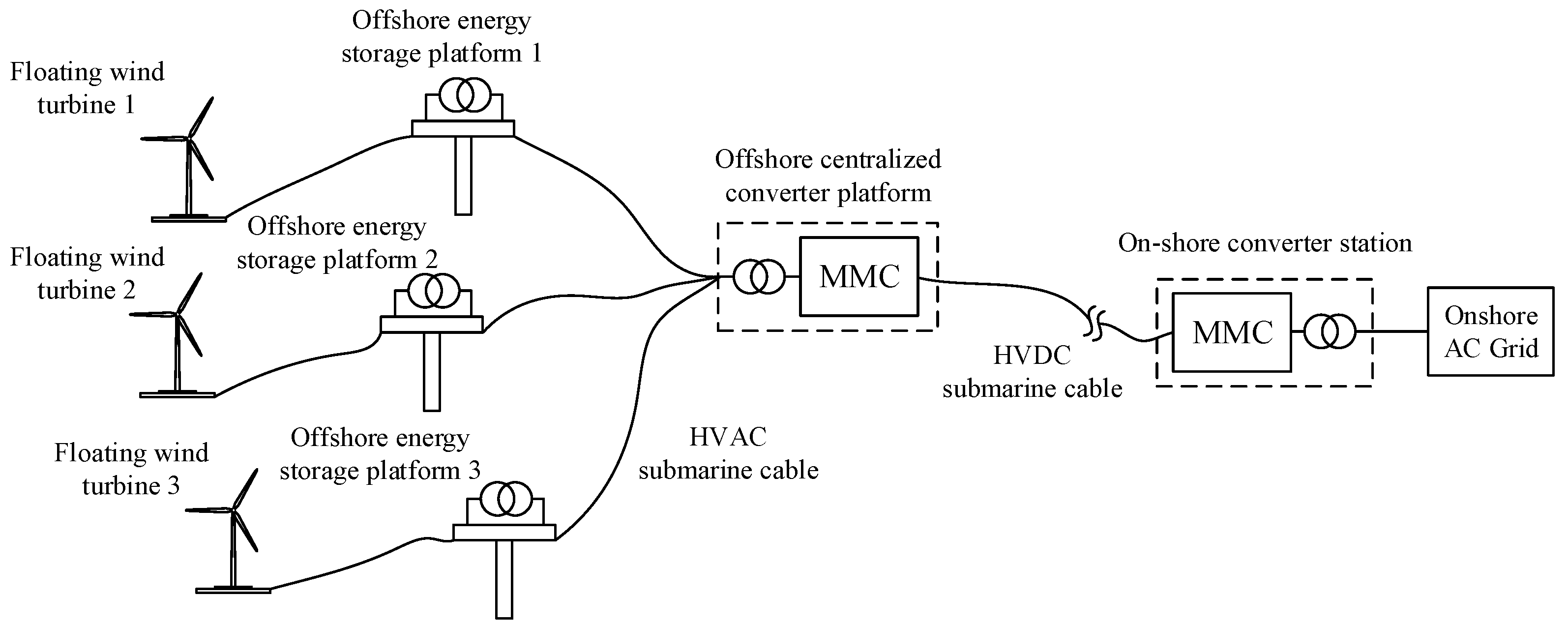
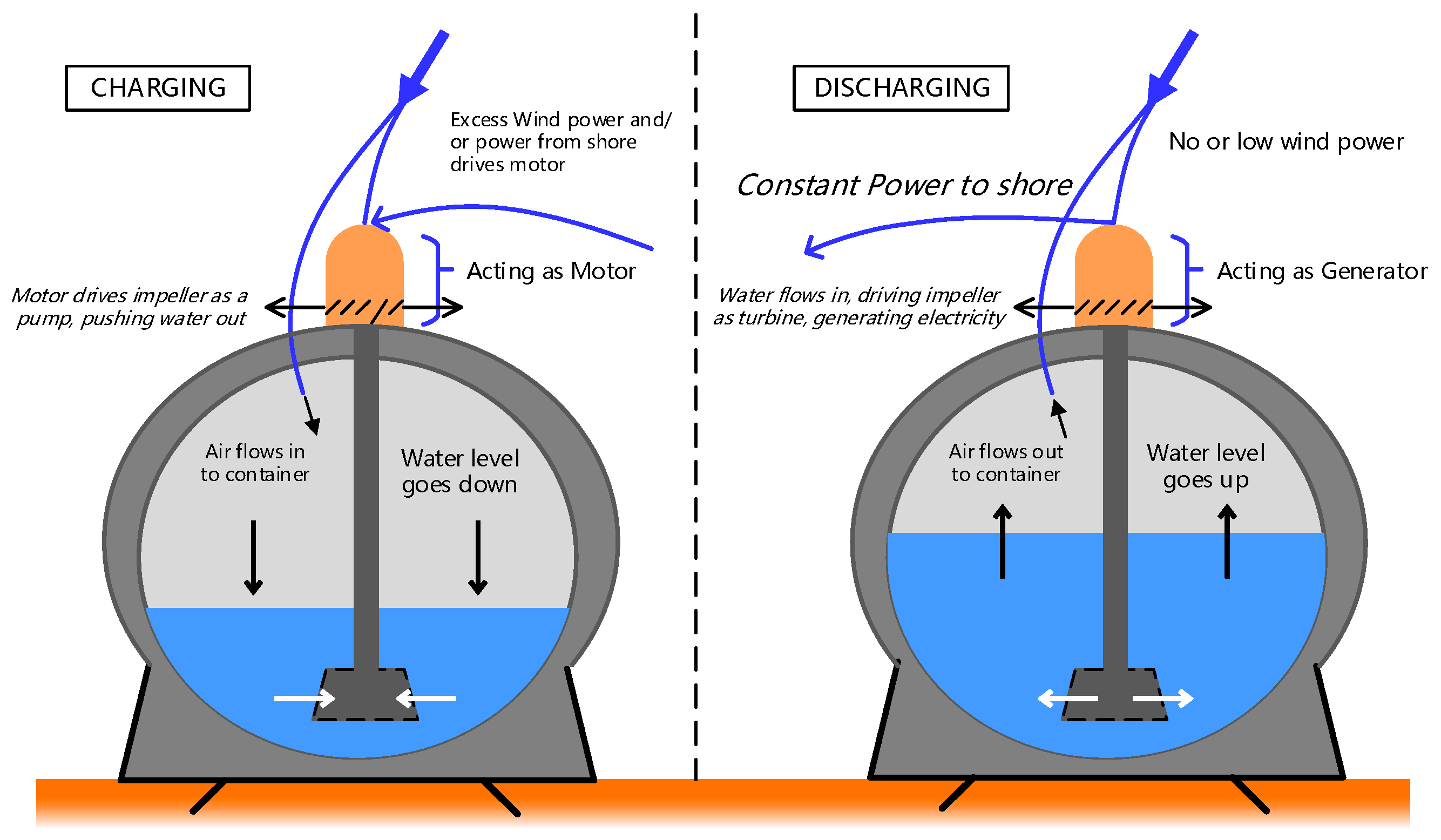
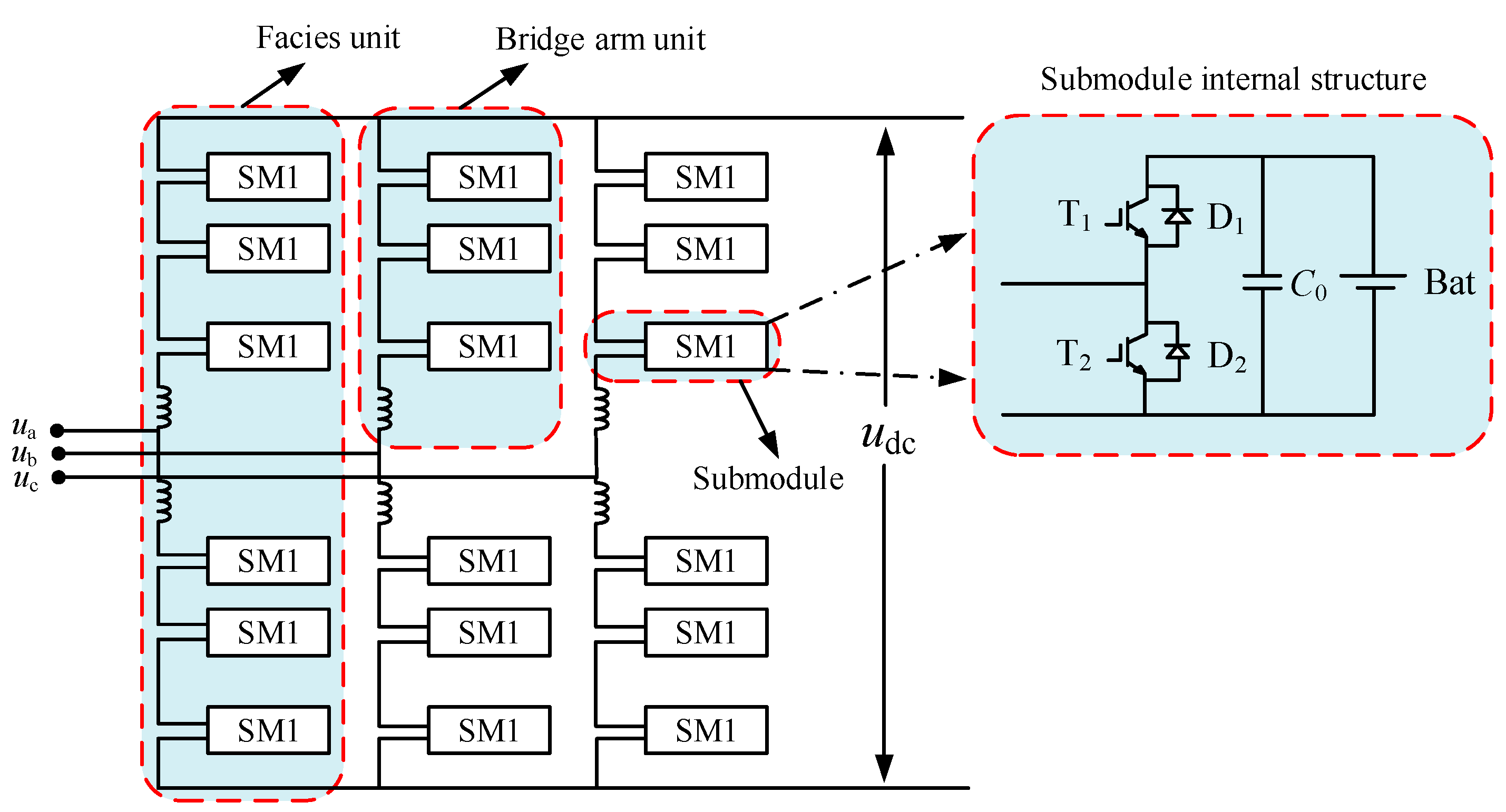

| Primary Parameters | Values |
|---|---|
| Rotor, hub diameter | 126 m, 3 m |
| Hub height | 90 m |
| Rotor mass | 110,000 kg |
| Nacelle mass | 240,000 kg |
| Tower mass | 347,460 kg |
| Platform mass (including ballast) | 5,452,000 kg |
| Platform dimensions | 40 × 40 × 10 m3 |
| Length from the reference point to the platform mass center and the portion above the mean sea level | 0.28 m, 63.90 m |
| Ref. No. | Method | Characteristics |
|---|---|---|
| [61] | Fast unfolding clustering algorithm. | Reduces fluctuations in offshore wind power output. |
| [63] | Offshore wind storage cooperative power control. | Maximizes offshore wind utilization and protects the grid and wind farms during typhoon periods. |
| [64] | Offshore wind storage cooperative frequency control. | Mitigates frequency shifts in case of faults in offshore wind farms or onshore grids. |
| [65] | Offshore wind storage cooperative frequency control. | Enables electrochemical energy storage to participate in frequency stabilization with droop control and virtual inertia control. |
| Ref. No | Method | Advantages | Disadvantages |
|---|---|---|---|
| [66] | Multi-objective optimization framework. | Integrates battery cost and lifetime, wind turbine availability, unsupplied expected energy, load hour losses, and wind energy limitations. | Requires large amounts of environmental data and complex calculations. |
| [67] | Multi-cycle optimal scheduling model. | Allows optimal charging and discharging power for offshore energy storage systems and minimizes total operating costs. | Long calculation time. |
| [68] | Economic model predictive control. | Improves the efficiency and economic performance of wind farms while extending the lifetime of energy storage systems. | The accuracy of the environmental model has a large impact on the control effect. |
| [69] | Improved NSGA-II. | Effective improvements in operating costs and power loss minimization. | Easy to fall into local optimum. |
| Ref. No. | Method | Advantages | Disadvantages |
|---|---|---|---|
| [79] | Double attention LSTM. | Improves the accuracy and interpretability of ultra-short-term offshore wind power output prediction. | Long calculation time. |
| [80] | Improved LSTM-TCN model. | Strong adaptability to common offshore conditions, such as sudden changes in wind speed. | Overfitting problems may occur. |
| [81] | Encoding–decoding framework for wind power model. | The atmospheric stability inside the offshore wind farm is considered to correct for the loss of the wake effect due to poor atmospheric stability. | The calculation process requires a large amount of computer memory. |
| [82] | Multi-objective gray wolf optimizer. | Effective improvements in operating costs and power loss minimization. | Easy to fall into local optimum. |
| [83] | Isolated forests and deep learning neural networks. | Improved stability and accuracy of predictions. | Does not work well with noisy data. |
| [84] | Deep neural networks. | Better copes with data uncertainty. | Network parameters are more difficult to adjust. |
| [85] | Swarm decomposition (SWD) and meta-extreme learning machine (Meta-ELM). | Faster and lower computational burden. | The computational accuracy of meta-limit learning machines is not as high as that of traditional neural networks. |
| Ref. No | Method | Advantages | Disadvantages |
|---|---|---|---|
| [106] | Pre-charging of the offshore MMC converter by an auxiliary generator. | Keeps inrush current at start-up within acceptable limits. | Requires additional power consumption. |
| [107] | Layered start-up control scheme. | Achieves minimal start-up power loss. | Start-up time will increase. |
| [108] | Improved recent level modulation method. | Reduces inrush current in passive side converters after pre-charging and effectively mitigates oscillations during MMC start-up. | Complex control process. |
| [109] | Zero-sequence modulation for adjusting circulating current rejection. | Improves the fault ride-through capability of MMC. | Stringent requirements for capacitive and inductive parameters in the circuit. |
| [110] | The voltage controller replaces the original AC side capacitor. | Switching between control modes with-out control logic allows for effective current limiting. | Greater controller cost. |
| [111] | Two-stage voltage drop control scheme and adaptive voltage rise control scheme. | Significantly improves post-fault recovery dynamics of DC voltages. | Slower fault recovery. |
Disclaimer/Publisher’s Note: The statements, opinions and data contained in all publications are solely those of the individual author(s) and contributor(s) and not of MDPI and/or the editor(s). MDPI and/or the editor(s) disclaim responsibility for any injury to people or property resulting from any ideas, methods, instructions or products referred to in the content. |
© 2023 by the authors. Licensee MDPI, Basel, Switzerland. This article is an open access article distributed under the terms and conditions of the Creative Commons Attribution (CC BY) license (https://creativecommons.org/licenses/by/4.0/).
Share and Cite
Zhou, B.; Zhang, Z.; Li, G.; Yang, D.; Santos, M. Review of Key Technologies for Offshore Floating Wind Power Generation. Energies 2023, 16, 710. https://doi.org/10.3390/en16020710
Zhou B, Zhang Z, Li G, Yang D, Santos M. Review of Key Technologies for Offshore Floating Wind Power Generation. Energies. 2023; 16(2):710. https://doi.org/10.3390/en16020710
Chicago/Turabian StyleZhou, Bowen, Zhibo Zhang, Guangdi Li, Dongsheng Yang, and Matilde Santos. 2023. "Review of Key Technologies for Offshore Floating Wind Power Generation" Energies 16, no. 2: 710. https://doi.org/10.3390/en16020710
APA StyleZhou, B., Zhang, Z., Li, G., Yang, D., & Santos, M. (2023). Review of Key Technologies for Offshore Floating Wind Power Generation. Energies, 16(2), 710. https://doi.org/10.3390/en16020710











